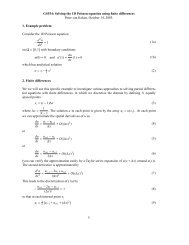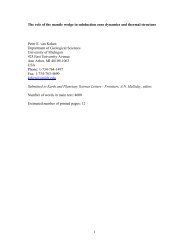Quantitative paleoenvironmental and paleoclimatic reconstruction ...
Quantitative paleoenvironmental and paleoclimatic reconstruction ...
Quantitative paleoenvironmental and paleoclimatic reconstruction ...
You also want an ePaper? Increase the reach of your titles
YUMPU automatically turns print PDFs into web optimized ePapers that Google loves.
ARTICLE IN PRESS<br />
N.D. Sheldon, N.J. Tabor / Earth-Science Reviews xxx (2009) xxx–xxx<br />
27<br />
7.2.3. Three-component soil CO 2<br />
On the basis of geological <strong>and</strong> chemical arguments, several studies<br />
have concluded that three-component CO 2 mixing relations can exist<br />
in various soils (Hsieh <strong>and</strong> Yapp, 1999; Yapp, 2001a,b; 2002; Tabor<br />
et al., 2004a,b; Tabor <strong>and</strong> Yapp, 2005b,c). As in 2-component CO 2<br />
mixing, 3-component mixing assumes soil CO 2 is represented by<br />
sources contributed from oxidation of organic matter <strong>and</strong> the global<br />
troposphere, but includes also a third component of CO 2 contributed<br />
from dissolution of pre-existing carbonate in the soil profile. Although<br />
carbonate may have very negative δ 13 C values in rare<br />
instances (e.g., one-component CO 2 mixing; Yemane et al., 1989;<br />
Tabor et al., 2007; Coney et al., 2007), CO 2 that is produced from<br />
dissolution of carbonate generally is enriched in 13 C relative to atmospheric<br />
CO 2 or CO 2 derived from oxidation of organic matter (e.g.,<br />
Hoefs, 1997; Criss, 1999; Sharp, 2007). As a result of these mixing<br />
relationships, pedogenic minerals that form in 3-component soil CO 2<br />
mixing systems are characterized (<strong>and</strong> for the most part recognized)<br />
by δ 13 C values more positive than 1- or 2-component soil CO 2<br />
mixing. Pedogenic minerals which may form in the presence of<br />
mixing of 3 soil CO 2 components include goethite (Hsieh <strong>and</strong> Yapp,<br />
1999; Yapp, 2001a, 2002; Tabor et al., 2004a,b; Tabor <strong>and</strong> Yapp,<br />
2005b,c), gibbsite (Tabor <strong>and</strong> Yapp, 2005a,b), <strong>and</strong> possibly calcite.<br />
7.3. Soil <strong>and</strong> paleosol carbonate<br />
Precipitation of carbonate in soil profiles is related to evapotranspiration,<br />
acidity of soil solution, temperature, <strong>and</strong> availability of<br />
metal cations (Ca 2+ ,Fe 2+ ,Mg 2+ ). Carbonates may form in virtually<br />
any climate <strong>and</strong> soil drainage class (e.g., Whelan <strong>and</strong> Roberts, 1973;<br />
Soil Survey Staff, 1975, 2003; Semeniuk <strong>and</strong> Meagher, 1981;<br />
Franzmeier et al., 1985; Buol et al., 2003; Aslan <strong>and</strong> Autin, 1998;<br />
Retallack, 2001a,b; Schaetzl <strong>and</strong> Anderson, 2005). In poorly drained,<br />
swampy <strong>and</strong> anoxic environments, pedogenic siderite (FeCO 3 ) is<br />
common (McMillan <strong>and</strong> Schwertmann, 1988; Ludvigson et al., 1998)<br />
<strong>and</strong> calcite may also form (Whelan <strong>and</strong> Roberts,1973; Aslan <strong>and</strong> Autin,<br />
1998; Tabor et al., 2007). However, pedogenic calcite is typically<br />
associated with well-drained soil profiles in sub-humid, semi-arid,<br />
<strong>and</strong> arid climates (e.g., Soil Survey Staff, 1975; Machette, 1985;<br />
McFadden <strong>and</strong> Tinsley, 1985; Buol et al., 2003; Schaetzl <strong>and</strong> Anderson,<br />
2005; Srivastava et al., 2002) characterized by relatively low rainfall<br />
(~b800 mm/yr; Jenny, 1941; Arkley, 1963; Gile et al., 1966; Retallack,<br />
1994; Royer, 1999) <strong>and</strong> high evapotranspiration (Thornthwaite, 1948;<br />
Srivastava et al., 2002). In these well-drained, dry-climate soils,<br />
aqueous Ca 2+ ions derived from dissolution of minerals are<br />
transported downward into the soil profile until precipitated as<br />
carbonate or removed from the soil through the groundwater system<br />
(Ekart et al., 1999; Tabor et al., 2006).<br />
Macroscopic forms of pedogenic carbonate-accumulation occur as<br />
filamentous, nodular, tubular, <strong>and</strong> completely indurated <strong>and</strong> massive<br />
or laminated horizons (Gile et al., 1966; Machette, 1985). Petrographic<br />
studies indicate that pedogenic carbonate crystal fabrics are dominantly<br />
micrite, with lesser amounts of microspar, sparite, needle fiber,<br />
radial-fibrous <strong>and</strong> radiaxial textures (Deutz et al., 2002, 2001; Brewer,<br />
1976; Loisy et al., 1999; Fig. 17). Although it is apparent that many<br />
different crystal morphologies may form in modern soils, non-micrite<br />
crystal textures in paleosol profiles are frequently suspected of postpedogenic<br />
(i.e., diagenetic) alteration (e.g., Cerling, 1991; Ekart et al.,<br />
1999; Deutz et al., 2001, 2002).<br />
Pedogenic carbonate mineralogy is overwhelmingly dominated by<br />
low-magnesium calcite (Jenny, 1941; Brewer, 1976; Freytet <strong>and</strong><br />
Verrecchia, 2002; Sparks, 2003). Therefore, the majority of stableisotope<br />
based <strong>paleoenvironmental</strong> <strong>and</strong> paleoclimatological <strong>reconstruction</strong>s<br />
from paleosol carbonate focus upon low-magnesium calcite<br />
(e.g., Cerling, 1991; Ekart et al., 1999). However, other pedogenic<br />
carbonate minerals have been reported in rare cases. Mineralogical<br />
studies of soil <strong>and</strong> paleosol carbonates have also identified dolomite,<br />
trona, ankerite, <strong>and</strong> siderite (Postma, 1983; McMillan <strong>and</strong> Schwertmann,<br />
1988).<br />
Kohur et al. (1995) identified microcrystalline dolomite from a soil<br />
profile within a saltpan soil in Alberta, Canada. Dolomite has also been<br />
identified in weakly developed soils forming upon basaltic parent<br />
materials in Hawaii, U.S.A. (Capo et al., 2000; Whipkey et al., 2002).<br />
Ankerite nodules have also been identified in paleosol profiles that<br />
underwent marine flooding (Mack et al., in revision). Trona (Na 2 CO 3·<br />
NaHCO 3·2H 2 O) has also been reported from shallow subsurface<br />
horizons of floodplain soils of Uttar Pradesh, India (Datta et al., 2002).<br />
The origins of pedogenic dolomite, ankerite <strong>and</strong> trona are not entirely<br />
clear, but they are likely related to high chemical activity of aqueous<br />
Mg 2+ , Fe 2+ , <strong>and</strong> Na + in soil solution in conjunction with rapid<br />
evapotranspiration of soil water, <strong>and</strong> they are considered to represent<br />
exceedingly rare phenomena. As a result, the occurrence of dolomite<br />
<strong>and</strong> ankerite in paleosol profiles is usually attributed to diagenetic<br />
processes exclusive of pedogenesis.<br />
Pedogenic siderite has been identified in modern soil-forming<br />
environments (Postma,1981,1982; Stoops,1983; L<strong>and</strong>uyt,1990; Brewer,<br />
1964) <strong>and</strong> paleosol profiles (Matsumoto <strong>and</strong> Iijima, 1981; Leckie et al.,<br />
1989; Mozley <strong>and</strong> Carothers, 1992; Brown <strong>and</strong> Kingston, 1993; Baker et<br />
al., 1996; Ludvigson et al., 1998; Jacobs et al., 2005; White et al., 2005).<br />
The presence of siderite in a soil or paleosol profile indicates formation<br />
in a reducing environment, low concentrations of aqueous sulfate,<br />
circum-neutral pH, <strong>and</strong> soil pCO 2 greater than 100,000 ppmV (Pearson,<br />
1979; Postma 1982; Bahrig, 1989; Pye et al., 1990). Although siderite is a<br />
common diagenetic alteration product (e.g., Mozley, 1988; Mozley <strong>and</strong><br />
Carothers, 1992), microspherulitic siderite (Spencer, 1925; seeFig. 17)<br />
appears to be strongly associated with pedogenesis in poorly drained,<br />
waterlogged soils (Stoops, 1983; L<strong>and</strong>uyt, 1990; Browne <strong>and</strong> Kingston,<br />
1993; Ludvigson et al., 1998; Ufnar et al., 2002, 2004; White et al., 2001,<br />
2005; Jacobs et al., 2005).<br />
7.3.1. Pedogenic calcite δ 18 O values<br />
The δ 18 O value of calcite is related to the δ 18 O value of the water<br />
from which it is derived, <strong>and</strong> the temperature of mineral crystallization<br />
(see equation of O'Neil et al., 1969 in Table 5). The potential of<br />
calcite oxygen isotope ratios as a paleotemperature proxy has been<br />
recognized for a very long time (McCrea, 1950; Epstein et al., 1953).<br />
Early studies acknowledged that δ 18 O values of soil (Salomons et al.,<br />
1978; Magaritz <strong>and</strong> Amiel, 1980; Magaritz et al., 1981; Rabenhorst<br />
et al., 1984; Cerling, 1984; Quade et al., 1989; Cerling <strong>and</strong> Quade, 1993)<br />
<strong>and</strong> paleosol (Quade et al., 1989; Mack et al., 1991; Yapp <strong>and</strong> Poths,<br />
1996) calcite are probably related to temperature of crystallization,<br />
but that its utility as a temperature proxy might be confounded by the<br />
effects of variable rainfall δ 18 O values at isothermal sites (e.g., Fig. 15;<br />
Cerling <strong>and</strong> Quade, 1993; Stern et al., 1997; Tabor <strong>and</strong> Montañez,<br />
2002) <strong>and</strong> modification of soil water δ 18 O values by evapotranspiration<br />
(Cerling, 1984; Mack et al., 1991; Stern et al., 1997; Tabor et al.,<br />
2002; Mack <strong>and</strong> Cole, 2005; Tabor <strong>and</strong> Montañez, 2005; Behrensmeyer<br />
et al., 2007; Tabor, 2007). In spite of these complicating factors,<br />
paleosol calcite δ 18 O values are still perceived as a useful indication of<br />
soil moisture δ 18 O values (Cerling, 1984; Quade et al., 1989; Cerling<br />
<strong>and</strong> Quade, 1993; Stern et al., 1997).<br />
7.3.1.1. Pedogenic calcite as a proxy for soil moisture δ 18 Ovalues. Several<br />
important studies have used the δ 18 O values of paleosol calcite as a<br />
monitor of rainfall δ 18 Ovalues.Quade et al. (1989) observed a large<br />
shift toward more positive paleosol calcite δ 18 O values in Miocene<br />
strata from Northern Pakistan that were deposited ~7 Myr before<br />
present. This positive oxygen isotope shift was subsequently<br />
identified in other areas around Asia (Stern et al., 1997; Sanyal et<br />
al., 2004; Behrensmeyer et al., 2007), <strong>and</strong> is interpreted to represent<br />
changing atmospheric circulation conditions (<strong>and</strong> precipitation δ 18 O<br />
values) over the Indian subcontinent, <strong>and</strong> intensification to the modern<br />
Asian monsoon system. In a large study of Miocene–Pleistocene<br />
Please cite this article as: Sheldon, N.D., Tabor, N.J., <strong>Quantitative</strong> <strong>paleoenvironmental</strong> <strong>and</strong> <strong>paleoclimatic</strong> <strong>reconstruction</strong> using paleosols, Earth-<br />
Science Reviews (2009), doi:10.1016/j.earscirev.2009.03.004















